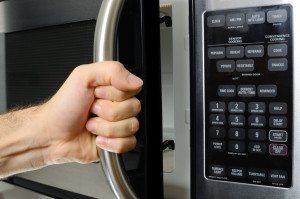Chances are, you’ve probably wondered, “Can I microwave that?” more than once or twice over the years. You rely on your microwave for all kinds of quick and efficient cooking and reheating tasks, but most people know precious little about how this appliance works. Consequently, you  may inadvertently try to nuke something you shouldn’t. Here is an overview of the types of things that should never go in a microwave oven.
may inadvertently try to nuke something you shouldn’t. Here is an overview of the types of things that should never go in a microwave oven.
Microwaves and Metal Don’t Mix
You probably know that metal is a no-no, but do you know why? Metal deflects the microwaves, sending them bouncing erratically around the interior of the oven like a tiny lightning storm, with a fire as the likely end result. This means no aluminum foil, no eating utensils, no Chinese take-out containers (metal handles), no plates or bowls with metallic trim and no travel mugs. Your travel mug might look perfectly harmless with no metal to be seen, but metal screws or clips are common inside. Never microwave food in a can or in any container that may have a residual foil seal around the top. Finally, take care with painted ceramics. Many ceramic paints derive their colors from metal-based pigments.
Take Special Care with Some Foods
Many fruits — grapes and raisins in particular — can explode in the microwave and catch fire. The same thing will happen to raw eggs in the shell. Even if a fire doesn’t occur, at best you will have a killer egg mess on your hands. Dried chilies are also dangerous, due to the volatility of their capsicum content. Fresh chilies and peppers can usually stand up to a brief spin but turn into potential grenades once removed, capable of shooting super-heated spicy juices. Hot dogs, potatoes and anything with an outer skin is dangerous, but as long as you poke a few vent holes, you should be fine. Finally, plain water has the potential to “super heat” and bubble over, causing burns. Add a wooden stir stick or chop stick to the container while you heat it and you’re good to go.
Other Items You Should Never Microwave
Some disposable plates and cups have plastic coatings that can’t stand up to the microwave. Both paper and plastic bags are dangerous, potentially releasing toxic gas or igniting. Most experts agree today that you should not reheat food in the microwave using Styrofoam or plastic containers (even those indicated as safe for that purpose), as it’s unknown what kinds of chemicals may leach out into the food. Despite what you may have heard, do not run your dish sponge through the microwave to disinfect it, as it can easily burst into flames. Never place a container in the microwave to help loosen a stuck lid or cap. The pressure inside builds very quickly and the container — glass or plastic — will explode. Finally, never run the microwave while empty. In the simplest terms, the microwave is liable to absorb its own waves and self-destruct.
If you live in Salt Lake City or the surrounding area and you’ve already done a number on your microwave, contact Complete Appliance Repair for help. They can get your trusty appliance back up and running in no time and, for good measure, help you answer that oft-asked question: Can I microwave that?

